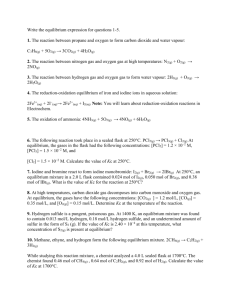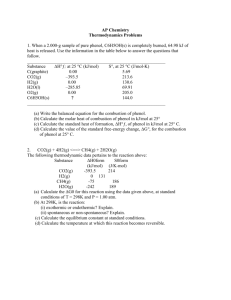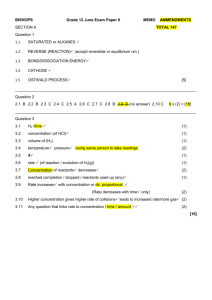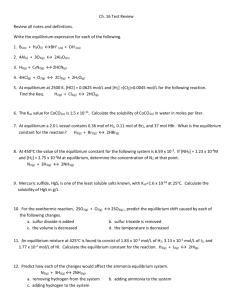12U_ Equilibrium_Test_Jan2010
advertisement
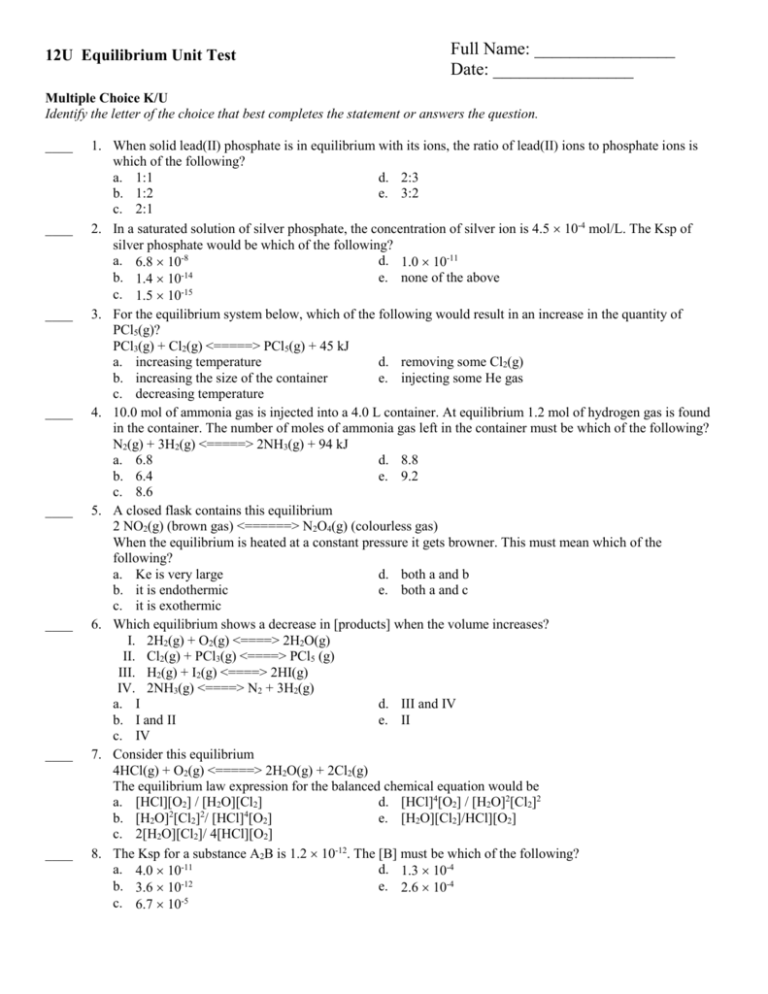
12U Equilibrium Unit Test Full Name: ________________ Date: ________________ Multiple Choice K/U Identify the letter of the choice that best completes the statement or answers the question. ____ ____ ____ ____ ____ ____ ____ ____ 1. When solid lead(II) phosphate is in equilibrium with its ions, the ratio of lead(II) ions to phosphate ions is which of the following? a. 1:1 d. 2:3 b. 1:2 e. 3:2 c. 2:1 2. In a saturated solution of silver phosphate, the concentration of silver ion is 4.5 10-4 mol/L. The Ksp of silver phosphate would be which of the following? a. 6.8 10-8 d. 1.0 10-11 -14 b. 1.4 10 e. none of the above c. 1.5 10-15 3. For the equilibrium system below, which of the following would result in an increase in the quantity of PCl5(g)? PCl3(g) + Cl2(g) <=====> PCl5(g) + 45 kJ a. increasing temperature d. removing some Cl2(g) b. increasing the size of the container e. injecting some He gas c. decreasing temperature 4. 10.0 mol of ammonia gas is injected into a 4.0 L container. At equilibrium 1.2 mol of hydrogen gas is found in the container. The number of moles of ammonia gas left in the container must be which of the following? N2(g) + 3H2(g) <=====> 2NH3(g) + 94 kJ a. 6.8 d. 8.8 b. 6.4 e. 9.2 c. 8.6 5. A closed flask contains this equilibrium 2 NO2(g) (brown gas) <======> N2O4(g) (colourless gas) When the equilibrium is heated at a constant pressure it gets browner. This must mean which of the following? a. Ke is very large d. both a and b b. it is endothermic e. both a and c c. it is exothermic 6. Which equilibrium shows a decrease in [products] when the volume increases? I. 2H2(g) + O2(g) <====> 2H2O(g) II. Cl2(g) + PCl3(g) <====> PCl5 (g) III. H2(g) + I2(g) <====> 2HI(g) IV. 2NH3(g) <====> N2 + 3H2(g) a. I d. III and IV b. I and II e. II c. IV 7. Consider this equilibrium 4HCl(g) + O2(g) <=====> 2H2O(g) + 2Cl2(g) The equilibrium law expression for the balanced chemical equation would be a. [HCl][O2] / [H2O][Cl2] d. [HCl]4[O2] / [H2O]2[Cl2]2 2 2 4 b. [H2O] [Cl2] / [HCl] [O2] e. [H2O][Cl2]/HCl][O2] c. 2[H2O][Cl2]/ 4[HCl][O2] 8. The Ksp for a substance A2B is 1.2 10-12. The [B] must be which of the following? a. 4.0 10-11 d. 1.3 10-4 -12 b. 3.6 10 e. 2.6 10-4 c. 6.7 10-5 2 ____ ____ ____ ____ ____ ____ ____ ____ 9. The Ksp expression for Al(OH)3 is Ksp = a. 3[Al][OH1-] d. 1/3[Al][OH1-]3 b. 3[Al][OH] e. [Al][OH1-]3 1- 3 c. 3[Al][OH ] 10. If a pH meter was placed in a 1.4 mol/L solution of nitric acid the reading would be which of the following? a. 1.4 d. 0.15 b. 14.15 e. 0.0 c. –0.15 11. Which of the following salts acts like a base when added to water? a. sodium perchlorate d. both a and b b. potassium nitrite e. both b and c c. lithium sulfite 12. The pH of a solution of HClO4 was found to be 3.4. The concentration of this solution in mol/L is which of the following? a. 4.0 10-4 d. 2.5 10-11 b. 3.4 e. none of the above c. 0.29 13. When solid NaOH is dissolved in water the temperature of the water rises. This system has which of the following? a. increased entropy and decreased enthalpy b. decreased entropy and increased enthalpy c. increased both entropy and enthalpy d. decreased both entropy and enthalpy e. none of the above are true 14. Kw is which of the following? a. the equilibrium constant for water which is always 1.0 10-14 b. Ka Kb for conjugate acid - base partners @ 25oC c. the log[H2O] @ 25oC d. both a and c e. none of the above 15. For sulfurous acid the Ka1 = a. [SO32-][H1+]2 / [H2SO3] d. [HSO31-][H1+] / [H2SO3] 21+ b. [HSO4 ][H ] / [H2SO3] e. [H2SO3] / [SO31-][H1+]2 11+ 2 c. [SO3 ][H ] / [H2SO3] 16. A solution of nitrous acid has a pH of 2.45. The [H1+] in mol/L and pOH must be respectively a. 3.5 10-3, 11.55 d. 2.8 10-12, 12 -3 b. 3.6 10 , 11.55 e. 3.8 10-3, 12.55 c. 2.8 10-12, 11.6 Short Answer (3 marks each) I/C 17. Consider the equilibrium below: If 1.5 mol of PCl5 was placed in a 1.0 L container and allowed to reach equilibrium, what would the value of Ke be if at equilibrium [PCl5] = 1.2 mol/L? PCl3(g) + Cl2(g) <=====> PCl5(g) 3 18. 8.0 moles of pure ammonia gas were injected into a 2.0-L flask and allowed to reach equilibrium according to the equation shown below. If the equilibrium mixture was analyzed and found to contain 2.0 moles of nitrogen gas, calculate the value of the equilibrium constant. 2NH3(g) <====> N2(g) + 3H2(g) 19. Explain the difference between a weak concentrated acid and a strong dilute acid. 20. If the pOH of a base solution at 25oC is 5.67, what is the pH and the [H1+], [OH1-] in mol/L? 21. Write the equilibrium expression for the self ionization of water. 22. If the solubility of Mg(OH)2 is 1.3 10-4 mol/L, what is its Ksp? 23. What mass of PbCl2 would be found in 0.48 L of a saturated solution of PbCl2 if the Ksp of PbCl2 is 1.6 10-5? 4 24. What is the concentration of a monoprotic weak acid if its pH is 5.50 and its Ka = 5.7 10 ? -10 25. Find the temperature at which the reaction below is spontaneous given this data Hfo of NH3(g) = - 46 kJ/mol, So of NH3(g) = 192.5 J/molK, So of N2(g) = 191.5 J/molK, So of H2(g) = 130.6 J/molK. N2(g) + 3H2(g) <=====> 2NH3(g) M.C. K/U Short Ans. I, C _____ 16 *** ____ 27 *** marked by: (first & last name): __________________________ 5 Chem12-Eqbm -- Answer Section 1E 7B 13 A 2B 8C 14 B 3C 9E 15 D 4E 10 C 16 A 5A 11 E 6B 12 A 17. ANS: mol/L PCl3(g) + Cl2(g) <=====> initial shift 0.3 0.3 @E 0.3 0.3 Ke = 1.2 / 0.3 0.3 = 13 PCl5(g) 1.5 0.3 1.2 18. ANS: mol/L 2NH3(g) <====> initial 4.0 shift –2.0 @E 2.0 Ke = (3.0)3(1.0) / (2.0)2 = 6.8 N2(g) + 1.0 1.0 3H2(g) 3.0 3.0 19. ANS: - A concentrated acid has lots of solute particles in a given volume. A dilute acid has a small number of solute particles in a given volume. A strong acid is completely ionized. A weak acid is only partially ionized. - A weak concentrated acid has a high concentration of undissociated particles. A strong dilute acid has only a small number of dissociated particles and no undissociated particles. 20. ANS: pH = 8.33, [H1+] = 4.7 10-9 mol/L., [OH1-] = 2.1 10-6 mol/L. 21. ANS: H2O + H2O <=====> OH1- + H3O1+ 22. ANS: Mg(OH)2(s) <====> @E Mg2+(aq) 1.3 10-4 + Ksp = 1.3 10-4 ( 2 * 1.3 10-4)2 = 8.8 10-12 2OH1-(aq) 2 * 1.3 10-4 6 23. ANS: PbCl2(s) <====> @E Pb2+(aq) + 2 Cl1-(aq) 2 1.6 10-5 = 43 = 1.59 10-2 mol/L mCu2S = (1.59 10-2 mol/L)(0.48 L)(278.11 g/mol) = 2.1 g 24. ANS: HX(aq) <=====> H1+(aq) + X1-(aq) x 10-pH 10-pH [H1+] = 10-pH = 10-5.50 [H1+] = 3.16 10-6 mol/L (3.16 10-6)2 / = 5.7 10-10 x = 1.8 10-2 mol/L 25. ANS: T = H / S = (-46 kJ/mol 2 mol) – 0 / (192.5 J/molK 2 mol) – (130.6 J/mol K 3 mol + 191.5 J/molK 1 mol) T = - 92 kJ / (385 J/K) – (391.8 J/K + 191.5 J/K) T = – 92 000 J / – 198.3 J/K T = 4.6 102 K


